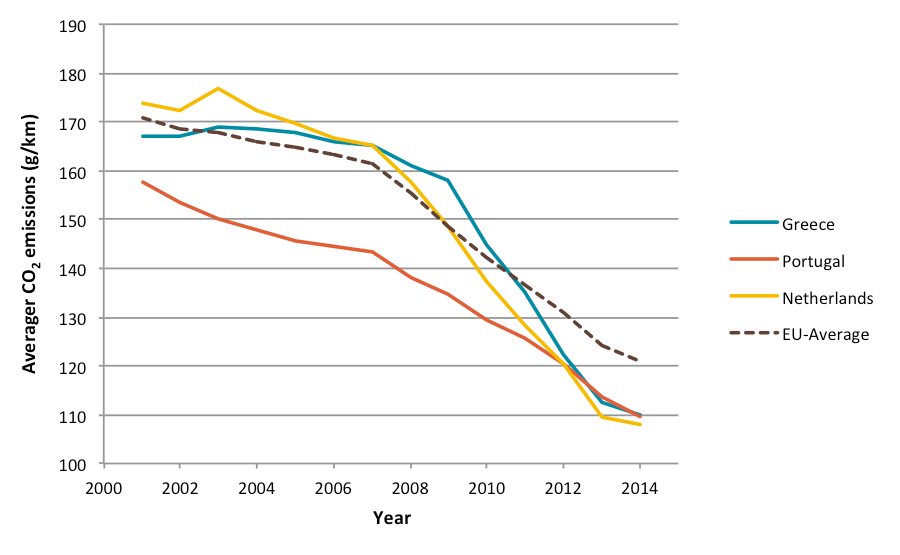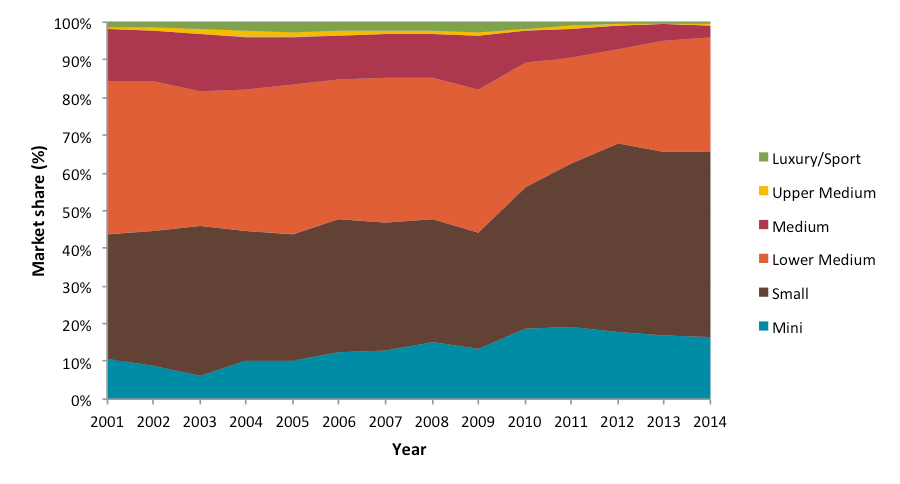Blog
Krisis, the Greek goddess of decreasing vehicle CO2 emissions
This week we published the 2015/16 edition of the European Vehicle Market Statistics Pocketbook. I first reviewed a draft of this new publication some time ago, during a visit to my hometown in Greece. Inside the apartment, with the temperature comfortably adjusted by the A/C, I cross-checked our vehicle data—passenger and light commercial new-vehicle registrations by fuel type, CO2 emissions, and lots of other interesting facts. When I took a break, I opened the balcony door and the traffic noise from the street below hit me in an instant. I gazed at the passing vehicles, cars, vans, and buses – I had just been looking at them on paper, now I was viewing the real thing. But what had happened to all the huge SUVs that used to lurk in the streets? And where were the noisy sport cars that would pass once in a while?
Greece isn’t in the spotlight these days just because of its sunny beaches. The on-going economic crisis has crippled incomes and job positions, while fuel prices aren’t low at the moment. But people still need to move around somehow, and while there are now more bikes on the streets, Thessaloniki hasn’t quite turned into Amsterdam. The streets of Greece are still crowded with cars, but the technical characteristics of these cars have changed dramatically in recent years.
If you look at the average CO2 emission level of new passenger cars in the EU, you’ll note that the Netherlands, Greece, and Portugal are the Member States with the lowest CO2 emission levels (see the figure below). The reduction in CO2 emissions in the Netherlands was achieved by strong fiscal incentives from government, in particular for plug-in and full battery electric vehicles.
But Greece is not full of charging stations. In fact, for many years, CO2 emission levels of new passenger cars in Greece were among the highest in the EU. Until they suddenly dropped in 2009. Over the next five years, Greece reduced vehicle CO2 emissions so rapidly that it managed to overtake every other EU country except the Netherlands. Of course, 2009 is also when the effects of the economic crisis began to be felt. But what exactly happened to the vehicle market in Greece that resulted in this reduction of new car CO2 emission levels?
Between 2009 and 2014 in Greece, the share of mini and small vehicles increased, while sales in other segments declined considerably (figure). The greatest impact can be seen on the medium segment, which diminished from 14% in 2009 to a mere 3% in 2014. Additionally, the percentages of upper-medium, luxury, and sport segments were almost completely wiped out by 2014. In general, new-vehicle sales also fell considerably; they were 67% lower in 2014 than in 2009, and 76% lower compared to 2001.
Low CO2 segments tend to better survive through the crisis, as they require less fuel to circulate and are more economical to acquire and maintain. This is particularly important in Greece, as the Greek government imposes a vehicle circulation tax that is based on engine capacity and vehicle CO2 emissions. For example, new cars emitting 120 g/km are subject to an annual tax of 108€, while vehicles emitting 140 g/km have to pay about 42% more annual tax. Lifting the ban on diesel vehicles in 2011, which were forbidden to circulate in Athens and Thessaloniki, has also shifted customer choices by providing a double benefit of lower fuel consumption and reduced CO2 emissions. Sales of diesels in the lower-medium segment rose from 8% in 2011 to 81% in 2014, and similar, if not so pronounced, trends are seen in the segments as well. In hard economic times, every Euro counts, and so a shift toward lower vehicle segments and increased dieselization in larger ones, is not surprising. In consequence, Greece now has one of the lowest-CO2 car fleets in the EU.
If you’re concerned about the warming climate and decarbonizing transportation, the past five years in Greece’s show a heartening trend, an annual reduction rate of 6% compared to 4% of the EU average for 2009–2014. But it is closely tied to an economic and political convulsion that every Greek—every European—wants to see end, and one that will eventually end. The Netherlands, on the other hand, has been incentivizing and promoting electric vehicles to reduce emissions. While hybrid and electric vehicles are exempted from registration tax in Greece, they are still expensive for the average customer. Until such technologies become widespread, turning to smaller vehicles can be one way of cutting back transportation CO2 emissions in Europe, as the example of Greece shows. But it would be better not to continue to rely upon the Greek goddess Krisis to cut transport emissions. Well-organized planning and policies for the transition to low and no carbon technologies, as the Netherlands example shows, can do the trick as well, and in the end they will prove the more sustainable approach.


